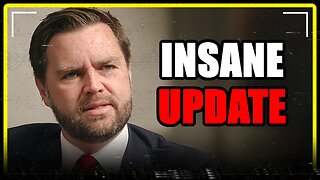Premium Only Content

Warning about the Safety & and Value of Your Money | The Gold Standard 2344
https://www.midasgoldgroup.com/
The knowledgeable Ken Russo joins series hostess Jennifer Horn for a lively discussion about the US economy. Buckle up as they tackle crucial topics that impact every wallet and purse: “Warnings about the Value and Security of Your Money.” In an era where our currency’s value rests solely on trust and confidence in the US Government, Jennifer and Ken attempt to unravel the complexity and layers of concern surrounding the reliability of our financial system. From dissecting the intricacies of our fractional reserve banking system to exploring what you need to know to safeguard your hard-earned dollars, Ken Russo takes the conversation beyond the headlines. He challenges people to think about the current geopolitical and economic situation regarding their finances.
Since President Nixon took the United States off the gold standard in 1971, the US dollar has experienced a significant loss in value. This departure from the gold-backed system allowed for more flexibility in monetary policy but came with consequences. The purchasing power of the US dollar has declined dramatically, with estimates suggesting it has lost approximately 95% of its value over the past five decades. This erosion includes inflation, increased money supply, and economic shifts. This devaluation underscores the importance of considering alternative assets.
“Trust your instincts and understand what is happening to your money. It’s going to continue to lose significant value.”
—Ken Russo
The recent collapse of The Citizens Bank in Sac City, Iowa, marks the fifth bank failure in the nation in 2023, shedding light on the fragility within the banking sector. While bank failures appear infrequent, with an average of nearly 25 per year since the new millennium, the back-to-back collapses of Silicon Valley Bank (SVB) and Signature Bank, followed by First Republic Bank just seven weeks later, underscore a unique and concerning trend. Between 2015 and 2020, the US witnessed an average of fewer than five bank failures annually, but the sudden uptick in 2023 prompts questions about banking stability. The most significant bank failure in US history, Washington Mutual in 2008, holding $307 billion in assets, is a reminder of potential repercussions when financial institutions buckle under the weight of risky endeavors.
The FDIC, or Federal Deposit Insurance Corporation, is an independent government agency overseeing the US banking industry. Formed in response to the widespread bank failures during the Great Depression of the 1930s, the FDIC’s mission was to renew confidence in the banking system by protecting depositors’ funds up to $2,500 per depositor. Today, the FDIC insures up to $250,000 per depositor, per account ownership type, per financial institution. It’s important to note that FDIC coverage doesn’t extend to investments like stocks or bonds. Beyond deposit insurance, the FDIC conducts supervision and examinations of banks and savings associations nationwide to ensure their sound operation.
While headquartered in Washington, DC, the FDIC is the primary federal regulatory agency for state-chartered banks not part of the Federal Reserve System. The FDIC enforces compliance with consumer protection laws, including the Fair Credit Billing Act, Truth in Lending Act, and Fair Debt Collection Practices Act.
The Dodd-Frank Wall Street Reform and Consumer Protection Act, enacted in 2010 in response to the 2007–2008 financial crisis, aimed to address regulatory shortcomings and protect consumers. Despite introducing measures such as the Orderly Liquidation Authority (OLA) to facilitate the orderly resolution of failing financial institutions, Dodd-Frank did not explicitly suspend bank bailouts. If necessary, OLA provided a mechanism for resolving failing institutions with temporary government financial support to prevent systemic collapse and protect the broader economy. While the act sought to make interventions more orderly and accountable, it did not eliminate the possibility of government involvement in stabilizing the financial system.
One of the original twenty-dollar Gold pieces, known as the Double Eagle Liberty Head, holds a storied legacy from its minting era between 1849 and 1907. Designed by James B. Longacre, the coin featured a majestic depiction of Lady Liberty wearing a coronet inscribed “Liberty.”
On the reverse side, a heraldic eagle graced the coin, clutching arrows and an olive branch. Notably, the Double Eagle underwent modifications, removing the motto “In God We Trust” in 1866, only to be reinstated in 1877 due to public outcry. This iconic piece of American numismatic history reflects the nation’s evolving ideals and the intricate artistry of the 19th and early 20th centuries.
____________________________________________________________________________________________________
Listen to The Gold Standard: https://www.midasgoldgroup.com/gold-standard-radio-show/
Gold IRA: https://www.midasgoldgroup.com/gold-ira/
Invest in Gold: https://www.midasgoldgroup.com/buy-gold/
Guide to Owning Bullion & Coins: https://www.midasgoldgroup.com/bullion-guide/
Read the latest precious metals news: https://www.midasgoldgroup.com/news/
-
 25:08
25:08
Midas Gold Group
1 year agoIf the System Collapsed, What Would Happen to My Money? | The Gold Standard 2432
59 -
 10:56
10:56
ariellescarcella
11 hours agoThe Shocking Divide Among College Voters Sparks Worry For America
733 -
 13:09
13:09
Forrest Galante
9 hours agoWildlife Expert Reacts To Deadly Australian Animal TikToks
25.7K3 -
 12:08
12:08
Zoufry
1 day agoThe Mystery of Gaddafi's Final 24 Hours
5.31K5 -
 18:25
18:25
Liberty Hangout
13 days agoAnti-Ice Demonstrators Love Poop!
38K47 -
 9:39
9:39
MattMorseTV
15 hours ago $0.99 earnedVance just DROPPED a BOMBSHELL.
35.6K63 -
 23:47
23:47
GritsGG
1 day agoThe Forgotten Best Sniper Support AR!
9.89K3 -
 1:15:48
1:15:48
The Pascal Show
17 hours ago $0.10 earnedMUGSHOTS RELEASED! Emmanuel Haro's Parents Mugshot Released To The Public
8.29K1 -
 14:45
14:45
BlabberingCollector
20 hours agoKings Cross Station SET LEAKS! | Harry Potter HBO Show Update & News
7.57K1 -
 33:20
33:20
SB Mowing
9 days agoHealth Struggles + Endless Rain = A Yard Out of Control
16.8K18